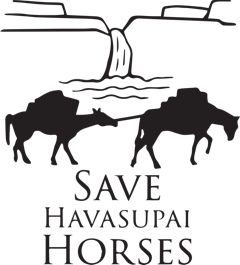A History of Violence
For more than 40 years, visitors to Havasu Falls near Supai, Arizona have been reporting on the gross neglect and abuse against the pack horses, mules and donkeys at the hands of certain tribal wranglers. These reports have accelerated greatly with the availability of social media.
Since its formation in February of 2016, SAVE has collected eyewitness accounts dating back 25 years which document the cruelty, and we continue to receive or find new testimony. Read SAVE's comprehensive report on the abuse.
The mission of Save Havasupai Horses is to end the starvation and abuse of the pack animals on the Havasupai reservation.
These horses, mules and donkeys have been subjected to the most horrifying treatment imaginable by a number of members of the Havasupai Tribe. Many of these animals live a tortured life that ends only when they drop dead due to overwork, starvation, lack of water, or lack of veterinary care. What abuse? Let us tell you.
THE PROBLEMS
This is what we know as fact: The pack animals at Supai are routinely starved, beaten, overloaded, rigged with inappropriate tack, whipped, blinded in an eye, worked while injured, and kicked unmercifully. Their owners often force them to gallop up and down a rugged, narrow, and steep 9-mile-long trail carrying over-sized loads up and down thousands of feet of elevation change. They are commonly tied together tightly using a “come along” rope around the neck - the sole purpose of which is to strangle them if they do not keep up.
At the trailhead commonly known as Hualapai Hilltop, there is no water, no food, and no shade for the pack animals. They are frequently tied to a railing so short they cannot move their heads. Temperatures during summer frequently exceed 100 degrees. They can be tied there with pack saddles on for hours - sometimes days.
Horses frequently collapse on the trail due to malnutrition, dehydration and exhaustion. Horses that fall or falter are beaten and kicked in an effort to make them get up. Along the trail there exists scattered evidence of dead and dying animals including trails of blood, skeletons, parts of half-eaten legs and burned bodies. Pack animals that don’t rise back up to their feet may be left, collapsed on the trail, to be eaten alive by feral dogs. Other are shoved off the side of the trail or burned.
Tribal wranglers do not bother to train these animals to do the job of a pack animal. Nor do they wait until an animal is old enough and sufficiently developed physically to perform such demanding work. A common approach, for example, is to kick one of an animal's eyes out to “make them more cautious on the trail." In short, every conceivable method of inflicting pain and suffering to these pack animals is used by some members of the tribe instead of appropriate training.
Tribal authorities do nothing to stop nor change these abusive practices. Third-party outfitters do nothing to exert a positive influence for diminishing these abuses. Instead, they continue to book trips and make tens of thousands of dollars off the raw backs of these horses, mules and donkeys. Federal authorities have looked the other way for years. And travel writers have penned - and still write - glowing articles about the blue-green waterfalls of Havasu Canyon, neglecting to mention how uninformed tourists can all too easily become unwitting accomplices to this enormous level of suffering.
Those are the problems. What are the answers? Read SAVE's position and solutions.

